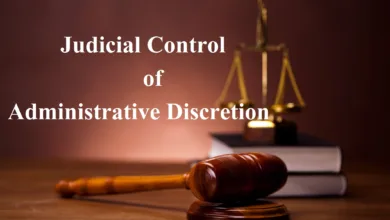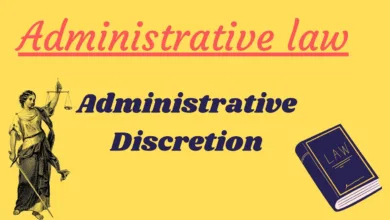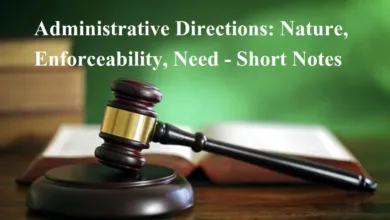Administrative Law
Relationship Between Constitutional Law and Administrative Law

Relationship Between Constitutional Law and Administrative Law
Constitutional law and administrative law are interrelated. Administrative law delves into the intricacies of administrative authorities’ organizations, powers, functions, and duties. Conversely, constitutional law encompasses the foundational principles governing these organizational structures, their powers, and their dynamic relationship with individuals.
- Interrelation and Distinctions: Constitutional law and administrative law are closely interrelated yet distinctly different. Administrative law governs administrative authorities’ powers, functions, and duties, while constitutional law establishes principles regarding these authorities’ organization, powers, and their relationship with individuals.
- Distinct Yet Complementary: While Constitutional Law focuses on the structure of government bodies at rest, Administrative Law deals with their functioning in motion. They are often intertwined, forming a platform for government accountability and responsibility. English Jurists emphasized their similarity rather than differentiation.
- Complex Relationship: India’s written Constitution and the concept of Judicial Review complicate the separation of these laws. There’s no clear demarcation between the two, necessitating a nuanced understanding. Constitutional Law serves as the foundation for Administrative Law, both being indispensable public laws.
- Jurisprudential Perspectives: Legal scholars like Holland, Ivor Jennings, and Locke offer distinct views. Jennings highlights organizational principles in Constitutional Law and administrative functions in Administrative Law. Locke’s clear distinction emphasizes that the state acts within legal boundaries.
- Administrative Law’s Scope: Administrative Law encompasses various aspects related to public administration, focusing on legal forms, authorities’ powers, duties, procedures, and their relationships with the public and employees.
- Doctrine of Water Shades: Dicey and Holland proposed this concept to delineate boundaries between both laws. However, a grey area persists, especially in India, where constitutional mechanisms regulate administrative agencies through specific constitutional provisions.
- Evolution and Origin: The growth of Administrative Law responds to changing state roles, addressing governance expectations, technological advancements, resource distribution challenges, and the need for efficient justice systems. Its roots trace back to ancient civilizations like the Mauryas and Guptas, highlighting well-structured administrative laws based on principles of justice and fairness.
Join our Telegram Groups
| Daily current affairs Updates | Click Here |
| Law Notes Free Channel | Click Here |
- Constitution as a Source: Constitutional Law stands as the primary source for Administrative Law in India. While ordinances under Articles 213 and 123 provide emergency provisions, they require subsequent approval.
- Hierarchy and Control: Constitutional Law reigns supreme, governing laws and their relations with the state and citizens. Administrative Law operates under these provisions, focusing on state functions. It’s essential to maintain a separate discipline to check arbitrary administrative actions and safeguard individual rights.
- Judicial Review and Enforcement: Courts play a pivotal role in scrutinizing administrative actions. They have the authority to strike down administrative actions or policies that contradict constitutional provisions, ensuring adherence to the Constitution.
- Shared Concerns: Administrative Law encompasses substantive aspects such as public health and education, reflecting Constitutional Law’s focus on public welfare. The Constitutional Law, in turn, monitors government branches and sets benchmarks for formulating policies and regulations.
- Integral Relationship: Constitutional Law and Administrative Law possess an intricate yet instrumental relationship. They operate as separate laws with a common area known as the ‘watershed area’ within Administrative Law, occasionally overlapping but remaining distinct in their focus and application.




